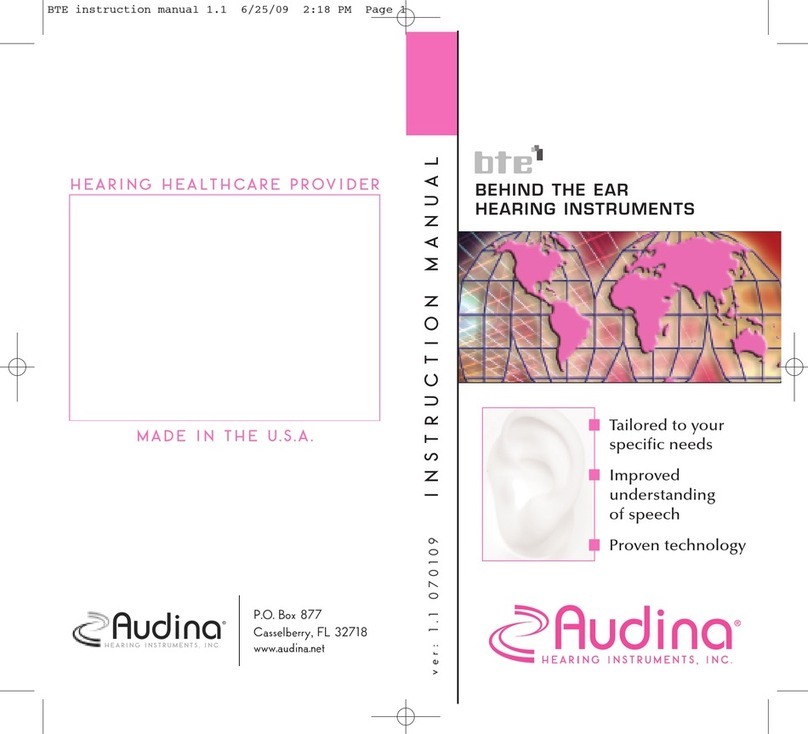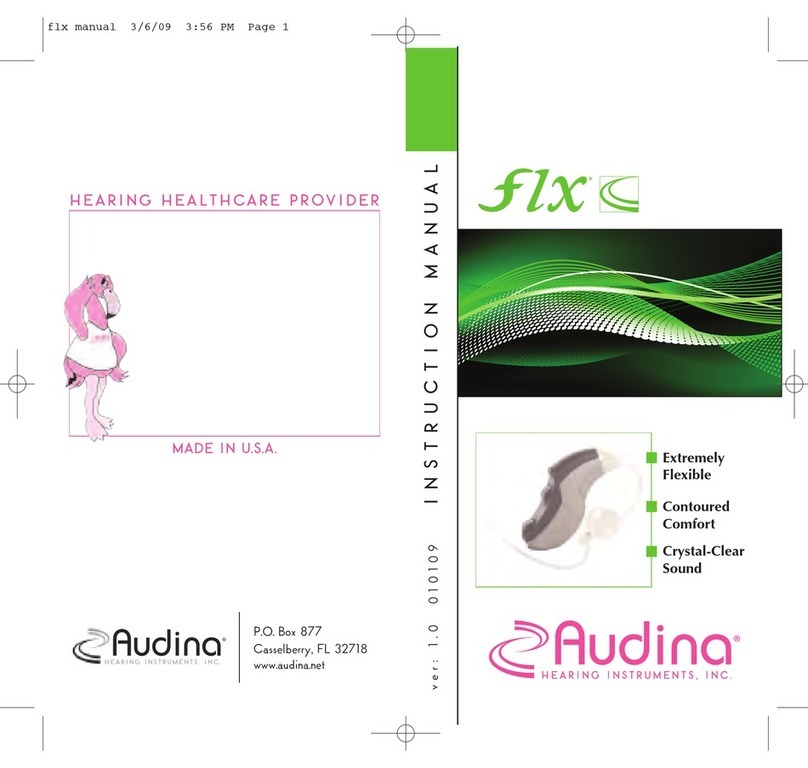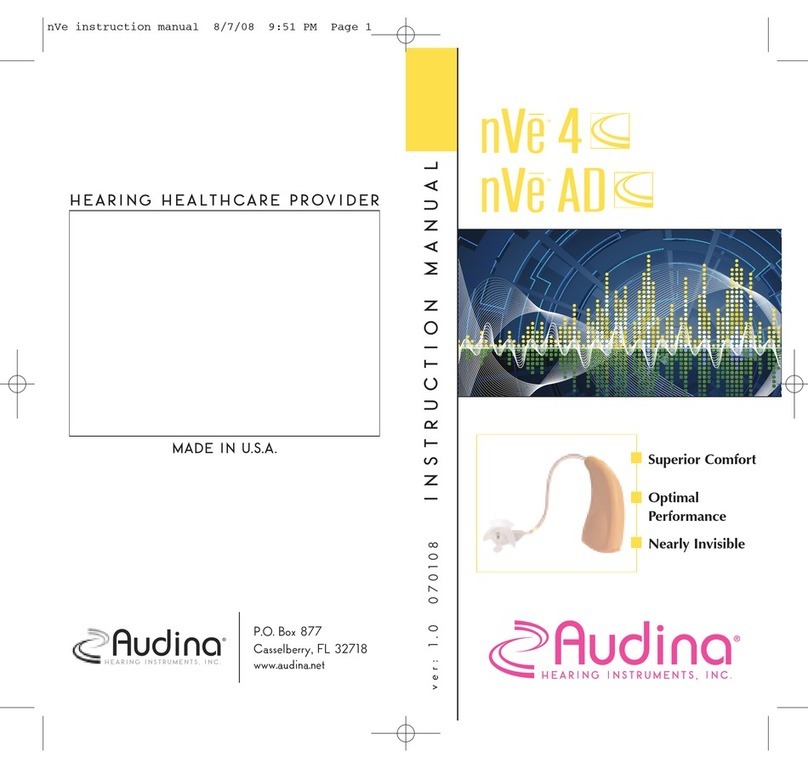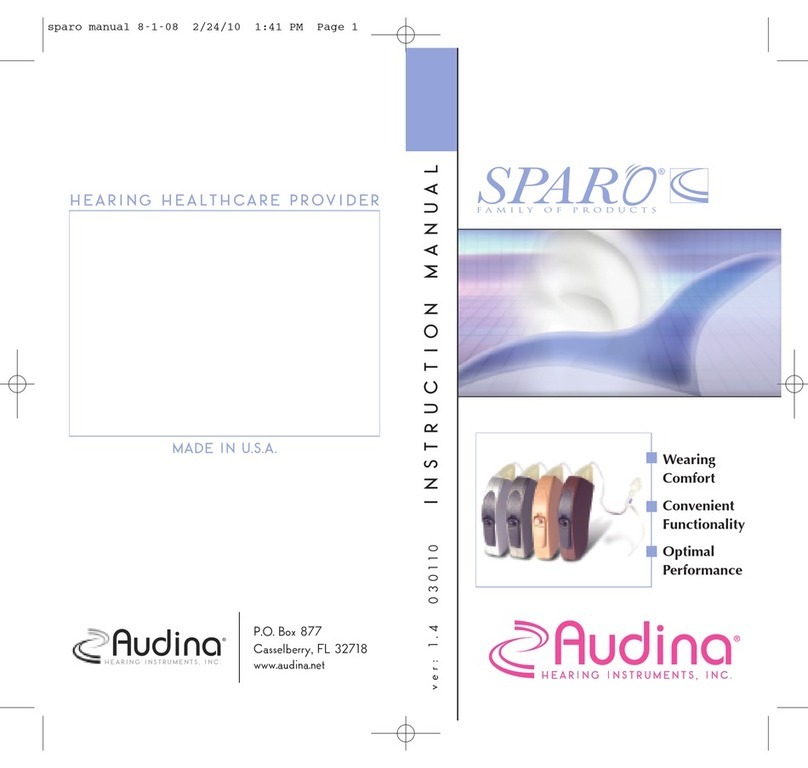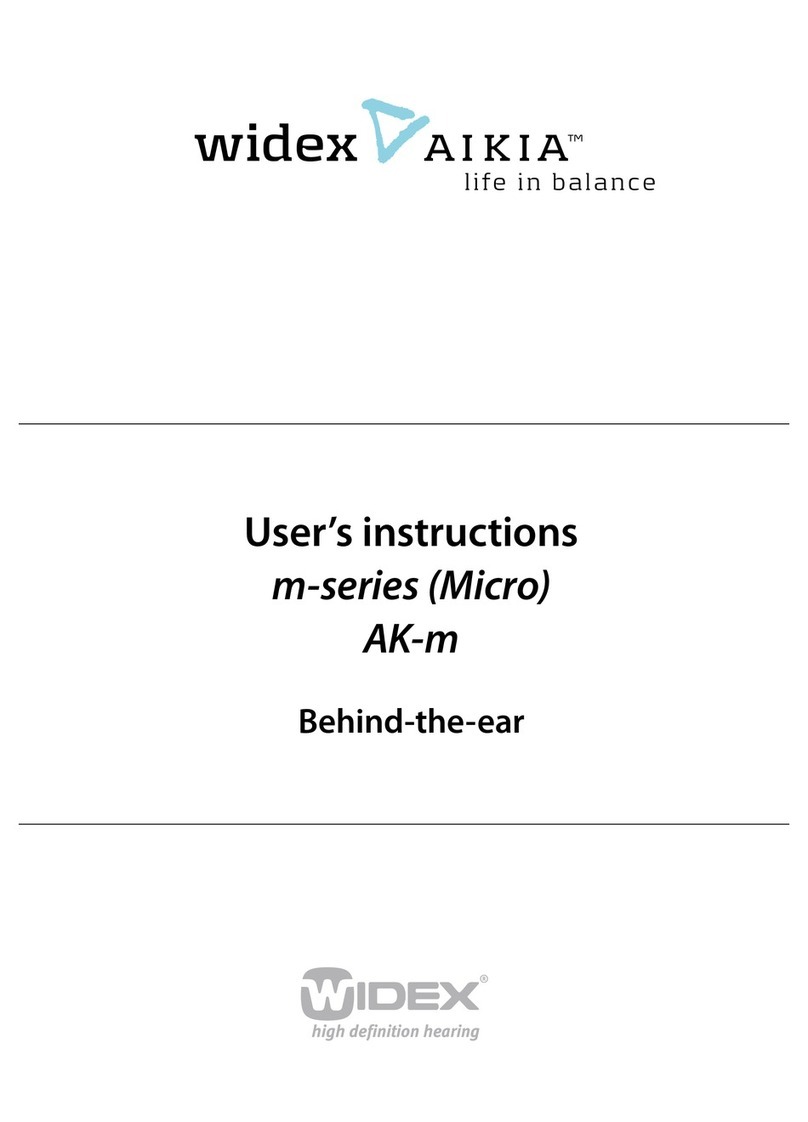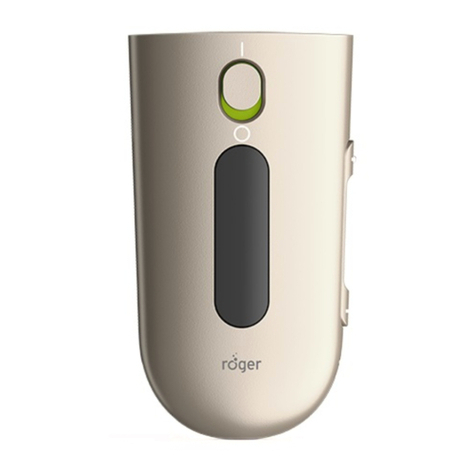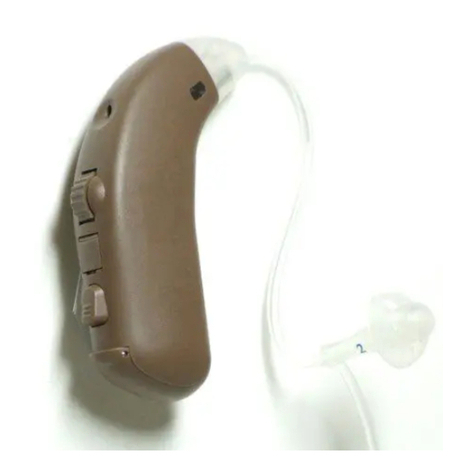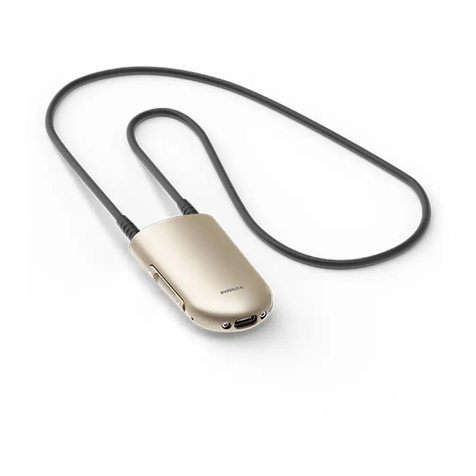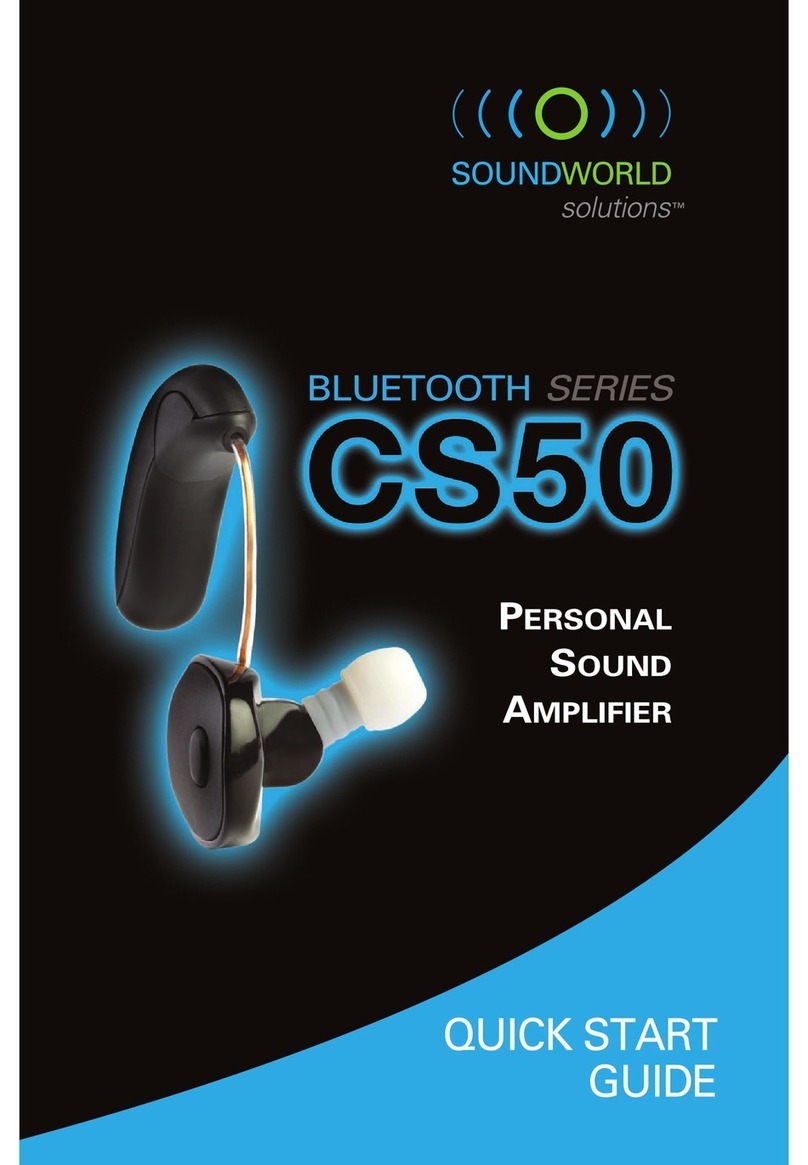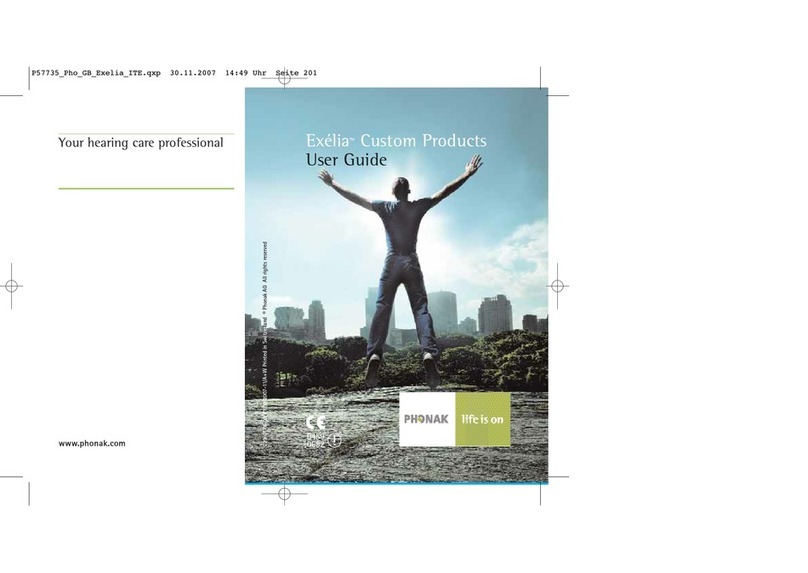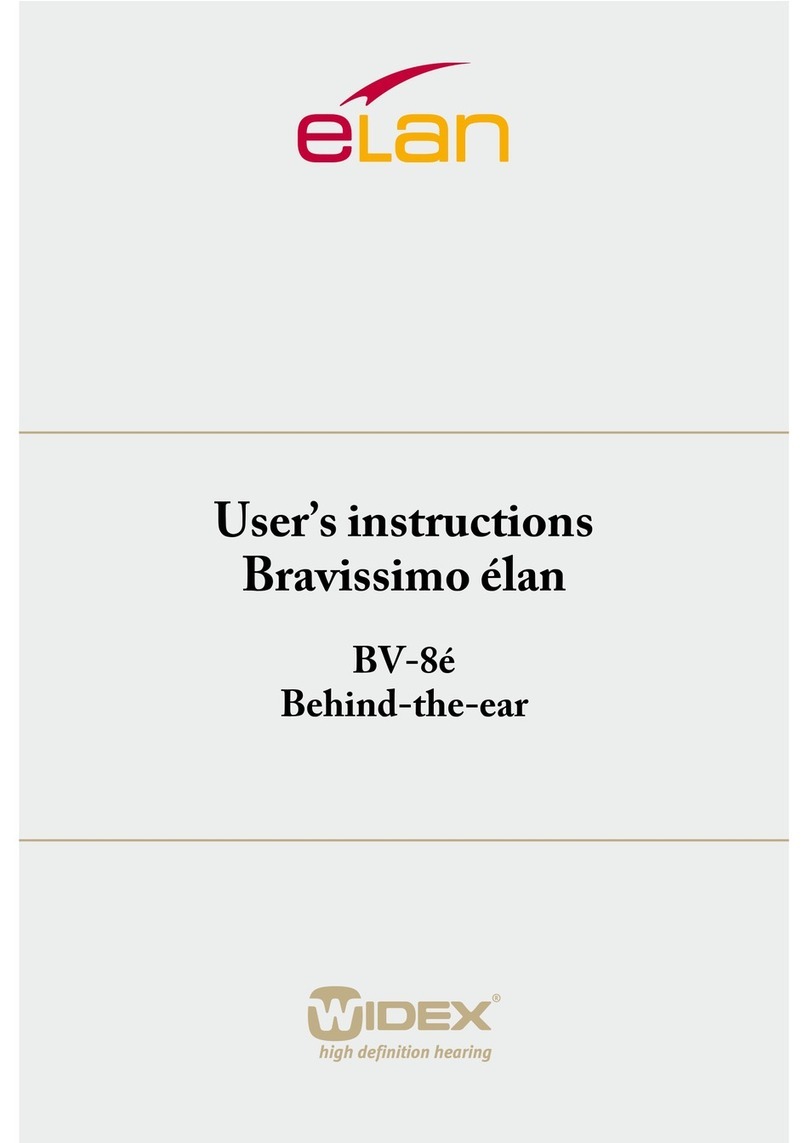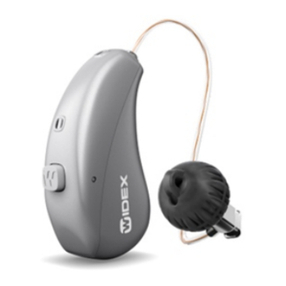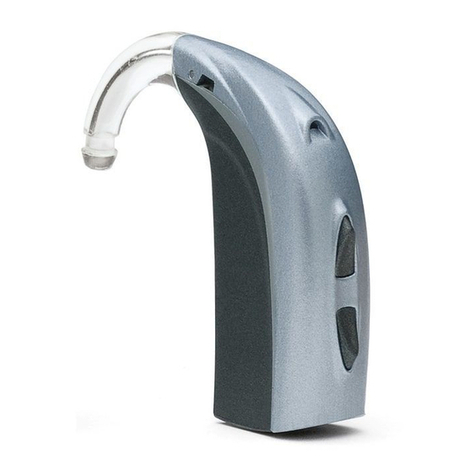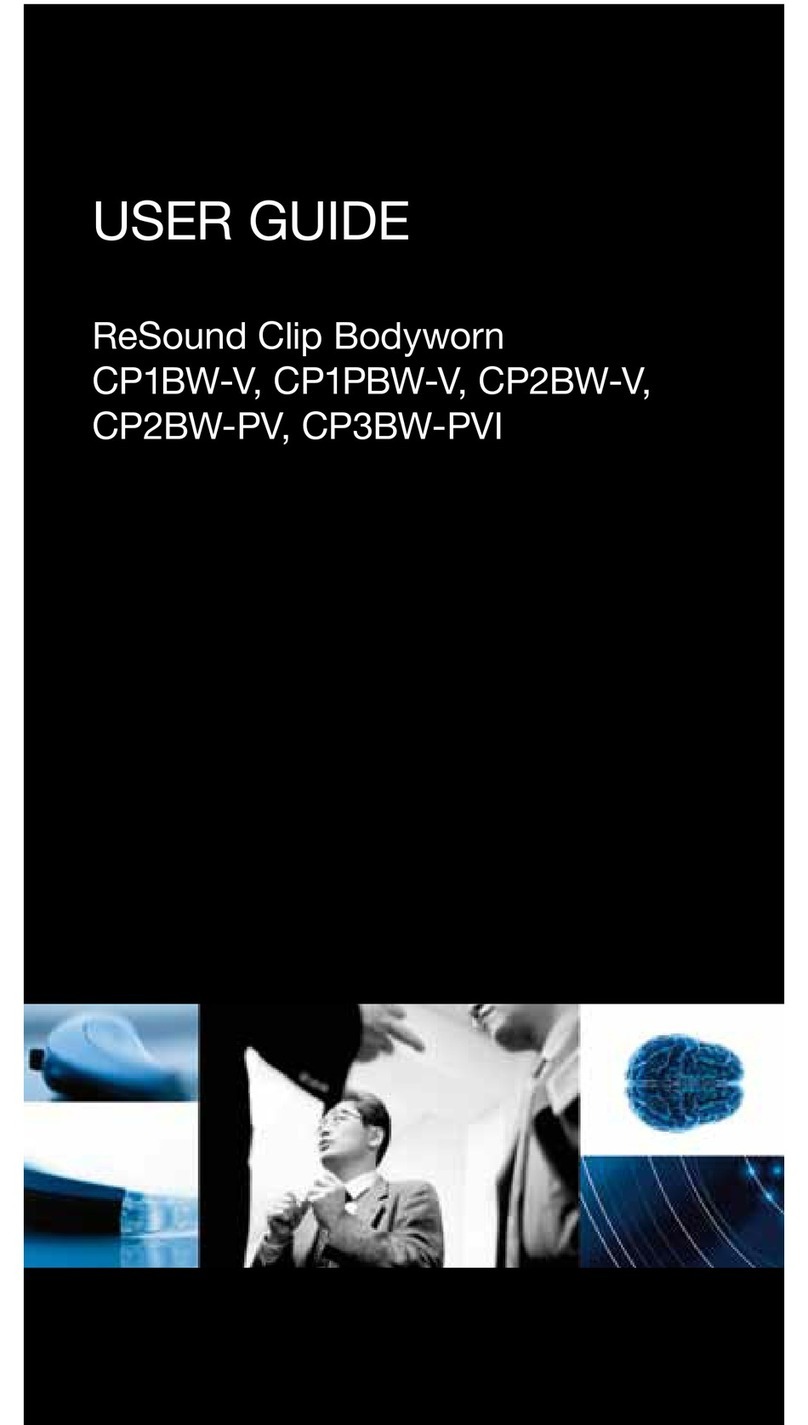Audina CUE MRIC User manual

MRIC
Mini-Behind the Ear
(Mini-BTE)
Hearing Instruments
■Small, contemporary design
■Excellent for active lifestyle
■Natural, Open-fit
INSTRUCTION MANUAL
ver: 1.0 09.01.11
Hearing Healthcare Provider
P. O. Box 180877
Casselberry, FL 32718-0877
audina.net
MICROPHONE & RECEIVER IN-THE-EAR
045 Cue MRIC Instruction Manual:Layout 1 10/17/11 3:01 PM Page 1

Cue M
RIC
Hearing Instrument
®
045 Cue MRIC Instruction Manual:Layout 1 10/17/11 3:01 PM Page 3

i
Welcome to a world of better hearing!
We understand that hearing loss affects
one’s quality of life. That is why we are
dedicated to building the highest quality
hearing instruments. Your new custom
hearing instruments will soon be
indispensable to you and will bring new
pleasure and enjoyment to your life.
Our company was established in 1990 and is
well-known internationally for offering high
quality, reliable, state-of-the-art technology.
These custom hearing instruments have
been programmed or adjusted to your
individual hearing loss to precisely fit your
hearing and communication requirements.
If necessary, your hearing healthcare
provider may make further modifications
to enhance your listening experience.
A period of adjustment may be needed
to become accustomed to your new
hearing instruments and the renewed
world of sounds you will experience. The
adjustment time varies for each individual
and may be as little as a couple of weeks to
as long as several months. Allow yourself
time to become familiar with those sounds
you have not heard for a long time.
Before operating your hearing instruments,
please read this manual thoroughly.
Welcome to a world of better hearing!
045 Cue MRIC Instruction Manual:Layout 1 10/17/11 3:01 PM Page 5

ii
Cue MRIC Diagram . . . . . . . . . . . . . . . . 1
On/Off Function . . . . . . . . . . . . . . . . . . . 2
Left and Right Instruments . . . . . . . . . . 3
Battery Information . . . . . . . . . . . . . . . . 3
Proper Placement in Ear . . . . . . . . . . . . . 5
Remove Cue MRIC from the Ear . . . . . . 7
Dome Styles . . . . . . . . . . . . . . . . . . . . . . 7
SoftTouch®Technology . . . . . . . . . . . . . . 9
Telephone Use . . . . . . . . . . . . . . . . . . . 11
Cell Phone Compatibility . . . . . . . . . . . . 11
Telecoil Option . . . . . . . . . . . . . . . . . . . 13
Cleaning Your Instrument . . . . . . . . . . . 14
Care and Storage . . . . . . . . . . . . . . . . . 18
Do’s and Don’ts . . . . . . . . . . . . . . . . . . 19
Troubleshooting . . . . . . . . . . . . . . . . . . 21
Service and Repair . . . . . . . . . . . . . . . . 23
Binaural Amplification . . . . . . . . . . . . . . 25
Children with Hearing Loss . . . . . . . . . 26
Notice to Prospective Users . . . . . . . . . 27
Notice to Providers . . . . . . . . . . . . . . . . 28
Warranty . . . . . . . . . . . . . . . . . . . . . . . . 29
Serial Numbers . . . . . . . . . . . . . . . . . . . 33
Owner Information . . . . . . . . . . . . . . . . 34
Table of Contents
045 Cue MRIC Instruction Manual:Layout 1 10/17/11 3:01 PM Page 7

21
C
2
5
6
4
1
A
B
3
89
10
7
Cue MRIC Diagram
Processor Module
Soft Domes
Battery (Size: 312 Zinc Air)
Battery Compartment
Connector Wire
MRIC Unit (microphone & receiver)
Microphone Opening
Receiver Opening
Telecoil Switch (optional)
Sound Opening
Open Dome
Closed Dome
Plus (+) Mark on Battery
A
B
C
1
2
3
4
5
6
7
8
9
10
To turn your hearing instrument “on”,
you simply need to close the battery door
after inserting a battery. To turn your
hearing instrument “off”, open the battery
door slightly to the first “click” as shown
in the illustration. This will disengage the
battery and turn off the hearing instrument.
In fact, when the hearing instrument is
not in use, it is recommended to open the
battery door completely and remove the
battery. This helps to prevent excessive
battery drain and allows for proper
ventilation of the hearing instrument.
On/Off Function
Click
045 Cue MRIC Instruction Manual:Layout 1 10/17/11 3:01 PM Page 9

3 4
If you are wearing hearing instruments in
both ears, it is important to use the correct
device in each ear. The MRIC (microphone
and receiver) modules are marked with
“red” lettering for the Right ear and “blue”
lettering for the Left ear. Once the device
has been fitted to one specific ear, you
should not wear it in the other ear. This
may lead to a deterioration of hearing
performance or hearing loss.
Left and Right Instruments
The Cue MRIC uses 312 Zinc Air batteries
indicated with a brown tabbed sticker. Your
digital hearing instruments are equipped
with a low battery indicator with a unique
acoustic fade feature. When the battery in
your hearing instrument is low, you will
hear a series of warning tones a few
minutes before the battery goes dead.
It is recommended that you install a fresh
battery at this time. Replacing a battery is
possible with the battery compartment
door completely opened.
Battery Information
To replace your hearing instrument battery,
follow these steps:
Step 1:
Lift the notch at the edge
of the battery compart-
ment and swing open the
door. Remove the battery
and dispose of properly.
Step 2:
Remove the colored tab
on the battery, and insert
the battery with + side up.
Step 3:
Swing the door into the closed position.
The compartment should close easily. Do
not force it. If resistance is noted, check
that the battery is inserted correctly.
045 Cue MRIC Instruction Manual:Layout 1 10/17/11 3:01 PM Page 11

5 6
The life of your hearing instruments’
batteries will vary depending on length of
daily use, listening environments, and how
your hearing instruments are programmed.
When the hearing instrument batteries
go dead, remove them immediately and
replace them with new batteries. Batteries
may be purchased through your hearing
healthcare professional.
When the hearing instruments are not
in use, open the battery compartment to
prevent excessive battery drain and
ventilate the instruments.
Important: Always discard used batteries.
Small batteries can be harmful if
swallowed. Keep batteries out of the
reach of pets and small children. In case
of ingestion, contact your physician or
call the National Button Battery Hotline at
202.625.3333.
The left and right hearing instruments can
be identified by the color coding on the
MRIC module:
Red = Right ear
Blue = Left ear
Your Cue MRIC instrument should fit
comfortable and easily over the top of your
ears. Your hearing healthcare provider will
provide instruction on proper insertion and
removal.
Step 1:
Place the hearing instrument over the top
of your ear with the MRIC unit (with soft
dome) loosely in the ear.
Step 2:
Insert the MRIC unit into the ear by
pressing on the outer end of the piece.
Step 3:
Continue to gently push the device deeper
into the ear. If your mouth is opened wide,
insertion will be easier.
Proper Placement in Ear
045 Cue MRIC Instruction Manual:Layout 1 10/17/11 3:01 PM Page 13

7 8
Ideally, the flat side of the MRIC piece
(where the microphone is situated) will
be flush to the entry of the ear canal
after insertion. In this way, the device is
practically invisible.
Make sure your hands are clean while
inserting the instrument. Make-up, hand
lotion, body oils, hair gel, hairspray and
similar products could make the MRIC
unit dirty or contribute to clogging of the
microphone opening.
Hold the connector wire gently but firmly
and pull it slowly out of the ear. Remove
the instrument from behind your ear.
Removing Cue MRIC from the Ear
The Cue MRIC uses soft domes available
in various sizes and shapes. The size
and shape of the soft dome to be used
depends on the size and shape of your
ear canal. Your hearing healthcare provider
will choose the correct size and shape for
your ear so the fit will be comfortable and
function properly.
An oversized soft dome may cause
discomfort and occlusion; while an
undersized soft dome may lead to MRIC
Dome Styles
movement in the ear canal causing
feedback (or whistling). Together you
and your hearing healthcare provider will
determine the soft dome that suits you
best during your fitting.
The soft dome is made of silicone and can
be replaced when necessary. One of the
most common hearing instrument repairs is
for damage to the receiver due to earwax.
The Cue MRIC soft domes have a built-in
wax protection system that prevents the
intrusion of earwax into the device. It is
important to use only the soft domes that
have been designed specifically for the Cue
instrument. Follow the maintenance and
cleaning instructions outlined in this manual
to experience the optimum performance
from your hearing instruments.
Open-fit Soft Domes
Several openings (holes) can be found on
the dome. Generally speaking, open soft
domes will have less amplification in the
lower frequencies than a closed soft-dome.
Open-fit soft domes are better suited for a
mild to moderate hearing loss.
Closed-fit Soft Domes
Closed fit soft domes support a wider
range of hearing losses. A side effect of
closed-fit soft domes is that your own voice
will sound louder than normal - this is called
occlusion.
045 Cue MRIC Instruction Manual:Layout 1 10/17/11 3:01 PM Page 15

910
Replacement of the Soft Dome
The soft dome may need to be changed if
it becomes stiff, brittle, kinked or damaged.
Only your hearing healthcare professional
should change the soft dome. This is to
prevent the soft dome from detaching from
the MRIC during insertion into the ear. If
your hearing healthcare provider instructs
you to change the soft dome yourself,
make sure it is securely fastened to the
MRIC before inserting it in your ear. Failure
to change the soft dome in accordance
with the instructions could result in injury.
With a simple touch to your ear, SoftTouch
allows you to change memories for up to
four different listening environments. Your
Cue instrument may be set for a single
touch, double touch or cover and touch.
Your hearing healthcare professional will
program the instrument during your initial
fitting for the style of touch you prefer.
SoftTouch®Technology
To change between the memories, gently
tap the ear with your hand, with fingers
together. A tone will be heard indicating
the number of the new memory that was
entered.
After inserting the battery, the instrument
will start in memory one. Gently tapping
the ear will produce two beeps, indicating
that memory two has been activated. After
another gentle tap, three beeps will be
heard indicating that memory three has
been activated. While memory four is
active, a gentle tap sets the device back
into memory one. One beep will be heard
indicating memory one is active.
045 Cue MRIC Instruction Manual:Layout 1 10/17/11 3:01 PM Page 17

1211
Because of the placement of the
microphone in your ear canal, you may
use any phone in the same manner as
you did prior to being fit with your Cue
hearing instrument. If feedback (whistling)
occurs, slightly pull the phone away from
your ear.
Telephone Use
Cell Phone Compatibility
Some hearing aid
users have reported
a buzzing sound in
their hearing aids
when they are
using cell phones,
indicating that the
cell phone and
hearing aid may
not be compatible.
According to the
ANSI C63.19
standard (ANSI
C63.19-2006 American National Standard
Methods of Measurement of Compatibility
Between Wireless Communications Devices
and Hearing Aids), the compatibility of a
particular hearing aid and cell phone can
be predicted by adding the rating for the
hearing aid immunity to the rating for the
cell phone emissions. For example, the
sum of a hearing aid rating of 2 (M2/T2)
and a telephone rating of 3 (M3/T3) would
result in a combined rating of 5. Any
combined rating that equals at least 5
would provide “normal use;” a combined
rating of 6 or greater would indicate
“excellent performance.”
The immunity of this hearing aid is M4. The
equipment performance measurements,
categories and system classifications are
based upon the best information available
but cannot guarantee that all users will
be satisfied. For your cell phone to be
compatible with these hearing instruments,
the cell phone immunity rating of M1 or
higher is required. Please consult your cell
phone specifications for your cell phone
immunity rating.
NOTE: The performance of individual
hearing aids may vary with individual cell
phones. Therefore, please try this hearing
aid with your cell phone or, if you are
purchasing a new phone, be sure to try it
with your hearing aid prior to purchase.
For additional guidance, please ask your
cell phone provider for the booklet entitled
“Hearing Aid Compatibility with Digital
Wireless Cell Phones.”
045 Cue MRIC Instruction Manual:Layout 1 10/17/11 3:01 PM Page 19

1413
The following instructions will assist
in extending the life of your hearing
instruments. The wearing of a hearing
instrument may accelerate the
accumulation of ear wax. This can easily
be removed by your physician or in some
cases your hearing healthcare provider.
You should not use cotton swabs to clean
your ears, due to the risk of pushing the
wax deeper into the ear canal.
The materials used in your hearing
instruments are of the highest quality
available, and the likelihood of an allergic
reaction is slight. If a skin irritation occurs,
including redness, swelling or itching
where the hearing aid makes contact
with your ear - contact your physician and
hearing healthcare provider.
To clean the exterior of the instrument:
You should inspect your hearing instruments
daily and clean them periodically to control
wax buildup. To clean, very gently wipe
the surface with a soft, dry cloth or moist
cleaning wipes made especially for hearing
instruments.
Do not allow water or liquid to enter any
openings on the instruments.
Cleaning Your Instrument
If your home, local theaters, auditoriums,
lecture halls or place of worship are
equipped with an inductive loop system,
the optional telecoil will allow specific audio
sources to connect to your hearing aid via
the loop system. The telecoil will also work
with neck loop Bluetooth technology.
The optional telecoil which is controlled
by a toggle switch is located on the back
of the processor module. The telecoil is
inactive when the switch is in the down
position. To activate the telecoil, place
the switch in the up position. The acoustic
microphone will be turned off when using
the ON telecoil feature.
Optional Telecoil (Inductive Loop System)
ON
OFF
045 Cue MRIC Instruction Manual:Layout 1 10/17/11 3:01 PM Page 21

1615
The buildup of earwax differs from person
to person. If the sound outlet of the soft
dome has been clogged, you may clean the
soft dome following the instruction in this
manual or visit your hearing healthcare
provider to have the soft dome replaced.
Check the instrument and soft dome daily
for clogs and damages. This guarantees
you optimal performance. If you notice that
the soft dome is damaged, it is important
that you do not continue to use it, have
it replaced at your service provider
immediately.
To keep the performance of your device
optimal and minimize the chance of
infection, we recommend you periodically
replace the soft dome with a new one.
Soft domes are available at your hearing
healthcare professional.
To clean the instrument body and MRIC module:
■Clean daily with a soft, dry lint-free
cloth
■In case of visible dirt, wipe with
special (moist) cleaning wipes made
specifically for hearing aids
■Be careful to avoid moisture entering
the small holes for the microphone or
the speaker, this could damage the
hearing instrument
To clean the soft dome:
■The soft domes should be cleaned
separately from the MRIC module. The
microphone and receiver could be
damaged if the soft domes are cleaned
together with the MRIC.
■Gently pull the soft dome straight
away from the MRIC module with your
finger tips as shown in illustration.
■Clean the soft dome daily with a soft,
dry lint-free cloth
■In case of visible dirt, you may clean
it with special (moist) cleaning wipes
made specifically for hearing aid
components.
045 Cue MRIC Instruction Manual:Layout 1 10/17/11 3:01 PM Page 23

1817
■After cleaning the soft dome, re-attach
to the MRIC module by gently pushing
it on so it fits snug at the neck of
the MRIC module as shown in the
illustrations.
■In case of severe dirt, change in the
sound or damage to the dome occurs,
it should be replaced by your hearing
healthcare professional.
■If in doubt, always consult your hearing
care professional for advice.
NOTE: Never use aggressive cleaning
products, abrasives or solvents! This
can cause damage to the soft dome or
the module.
Hearing instruments are exposed to
moisture in the form of humidity and
perspiration while being worn. The daily
use of a dehumidifying system or drying
kit approved by your hearing healthcare
provider is recommended. These
accessories may be purchased from
your hearing healthcare provider.
The most common causes of hearing
instrument repair are wax and moisture.
If you are encountering recurrent repairs,
please discuss the various wax/moisture
prevention systems and accessories with
your hearing healthcare provider.
At night:
Open the battery door slightly to shut the
device off. This will increase the operational
life of the battery. Store the device in a
secure cool, dry location outside of its box;
this allows for the evaporation of any
moisture in the device. It is recommended
to store your hearing instrument in a
dehumidifier system designed for
hearing aids.
Care and Storage
045 Cue MRIC Instruction Manual:Layout 1 10/17/11 3:01 PM Page 25

2019
Short-term storage:
Use the provided carrying box when you
want to remove the device from the ear
temporarily. Do not carry the hearing aid
unprotected in your pocket, purse, or bag
as other items may cause damage to the
instrument.
Long-term storage:
When not using your hearing aid for longer
periods of time, clean the module and soft
dome according to instructions outlined
in this manual before storing them inside
the carrying box or a hearing instrument
dehumidifier. Always remove the battery
from the instrument before storing.
Do always wear this instrument with the
soft dome tightly attached to the MRIC
module.
Do store the instruments overnight in a
hearing aid dehumidifier to absorb
moisture (Be sure and remove
batteries first).
Do always carry spare batteries.
Do replace the battery when the low-
battery warning beep sequence begins.
Do always care for your instrument as
outlined in this manual.
The Do’s and Don'ts of Hearing Instruments
Do dry the battery contacts with a cotton
swab in cases of humid weather or
heavy perspiration.
Do safely store hearing instruments when
not in use. Keep them out of the reach
of small children and pets.
Do remove your hearing instruments if you
are going to have X-rays at your dentist
or medical facility. It is best to keep
them outside the room of the X-ray
equipment.
Don’t leave your hearing instruments on
the radiator, near a stove, in a sunny
window, in a car or in any other hot
place. Excessive heat and cold can
damage the instruments.
Don’t drop your hearing instruments on any
hard surface.
Don’t wear the hearing instruments when
using a hair dryer at home or when at
the beauty salon, spa or barber.
Don’t wear the hearing instruments when
having medical tests done such as
MRI, X-rays or CT scans; as different
types of radiation may damage the
hearing instrument.
Don’t apply hair spray when wearing
your hearing instruments. It may
damage the instrument.
045 Cue MRIC Instruction Manual:Layout 1 10/17/11 3:01 PM Page 27

21 22
Don’t wear the instruments while taking a
bath, shower, spa treatment or while
swimming.
Don’t store the instruments in the
bathroom during a shower or near a
steam room as moisture created by
the steam may cause damage.
No Sound:
■Ensure that hearing instruments are
turned on.
■Replace the battery.
■Ensure that there is no wax or debris
in the soft dome.
Not loud enough:
■Replace the battery.
■Ensure that there is no wax or debris
in the sound tube.
■Ensure that hearing instruments are
placed up, behind the ear and the
MRIC module is placed properly into
the ear canal.
■Excessive earwax can prevent sound
from entering the ear. Contact your
physician or hearing healthcare
provider.
Troubleshooting Guidelines
■Changes in your hearing loss can
affect how you hear with a hearing
aid. Contact your hearing healthcare
provider if you suspect any change in
your hearing status.
Whistling / Feedback:
■Ensure that hearing instruments are
properly placed up, behind the ear and
the MRIC module is put into the ear
canal.
■Excessive earwax and improperly
sized instruments can cause whistling.
Contact your hearing healthcare provider.
Sound is Distorted or Unclear:
■Replace the battery.
■Hearing instruments may have a
poor battery contact or may not be
programmed properly. Return to your
hearing healthcare provider.
Intermittent Sound:
■Replace the battery.
■Ensure that there is no wax or debris
in the soft dome.
■Hearing instruments may have a poor
battery contact. Return to your hearing
healthcare provider.
Too Much Bass:
■Hearing instruments may need
reprogramming. Return to your
hearing healthcare provider.
045 Cue MRIC Instruction Manual:Layout 1 10/17/11 3:01 PM Page 29

23 24
Static Noise:
■Replace the battery.
■If you are near an electromagnetic
field (i.e. near a computer screen or
fluorescent lights), step away to see
if the static clears.
■Hearing instruments may have a poor
battery contact. Return to your hearing
healthcare provider.
You should visit your hearing healthcare
provider if your hearing instruments are in
need of service. If you no longer have a
hearing healthcare provider and are in need
of one, you may contact Audina and we will
assist you in finding one in your area. If you
are unable to visit a hearing healthcare
provider, you may send your hearing aids
directly to the manufacturer.
Before planning to return your instruments
for repair, please refer to the troubleshooting
chart on the preceding pages. Many times
these solutions can prevent the time and
cost associated with a repair.
Service and Repair Information
If you need to send your instruments
directly to the manufacturer, carefully
pack your instruments in a sturdy box
and send it to:
Audina®Hearing Instruments, Inc.
P. O. Box 180877
Casselberry, FL 32718-0877
You must include your current phone
number and home address. There is a
$40 charge to cover shipping and handling.
Please include a check, payable to Audina
Hearing Instruments, Inc. for said amount
when sending your instruments for service.
It is recommended to purchase shipping
insurance when sending your hearing aids
to the manufacturer.
If your hearing instruments are out of
warranty, we will assist you in finding a
hearing healthcare provider in your local
area.
045 Cue MRIC Instruction Manual:Layout 1 10/17/11 3:01 PM Page 31

2625
Hearing loss can be improved, in most
cases, through medicine, surgery, or with
hearing instruments. Hearing aids are the
most commonly chosen option.
Today’s hearing instruments are quite small
in size and feature sophisticated electronics
that accommodate a wide variety of
hearing losses. Nature gave us two ears for
a reason and since the majority of people
who have a hearing loss are affected
in both ears, two (binaural) hearing
instruments are typically recommended.
Two hearing instruments should provide
these benefits:
■Better overall sound quality when
compared to one hearing instrument
(“stereo sound”).
■The ability to locate a sound source in
noisy and normal listening conditions.
■Increased ability to understand
speech in noisy and normal listening
conditions.
■A sensation of balanced hearing.
Talk with your hearing healthcare provider
about what is best for you. Even the best
technology can’t do the work of two ears!
Binaural Amplification Children with Hearing Loss
In addition to seeing a physician for a
medical evaluation, a child with a hearing
loss should be directed to an audiologist for
evaluation and rehabilitation since hearing
loss may cause problems in language
development and the education and social
growth of a child. An audiologist is qualified
by training and experience to assist in the
evaluation and rehabilitation of a child with
hearing loss.
045 Cue MRIC Instruction Manual:Layout 1 10/17/11 3:01 PM Page 33

28
Federal law allows a fully informed adult
to sign a waiver statement declining the
medical evaluation for religious or personal
beliefs that preclude consultation with a
physician. The exercise of such a waiver is
not in your best interest, and its use is
strongly discouraged.
Notice for Hearing Healthcare Providers
Hearing healthcare providers should
advise a prospective hearing instrument
user to consult promptly with a licensed
physician (preferably an ear specialist)
before dispensing a hearing instrument if
the hearing healthcare provider determines
through inquiry, actual observation, or
review of any other available information,
that the prospective user has any of the
following conditions:
■Visible congenital or traumatic deformity
of the ear.
■History of active drainage from the ear
within the previous 90 days.
■History of sudden or rapidly progressive
hearing loss within the previous 90 days.
■Acute or chronic dizziness.
■Unilateral hearing loss of sudden or
recent onset within the previous 90 days.
27
Notice to Prospective Users
Good health practice requires that a person
with a hearing loss have a medical exam
by a licensed physician, who specializes in
diseases of the ear, before purchasing a
hearing instrument.
Licensed physicians who specialize in the
diseases of the ear are often referred to as
Otologists, Otolaryngologists (ear, nose and
throat – ENT) or Otorhinolaryngologists.
The purpose of a medical evaluation
is to assure that all medically treatable
conditions that may affect hearing are
identified and treated before the hearing
instrument is purchased. Following the
medical evaluation, the physician will give
you a written statement that your hearing
loss has been medically evaluated and that
you may be considered a candidate for a
hearing instrument.
A hearing specialist will conduct an
evaluation to assess your ability to hear.
The hearing instrument evaluation will
enable the hearing specialist to select and
fit a hearing instrument to your individual
needs. Federal law restricts the sale of
hearing instruments to those individuals
who have obtained a medical evaluation
from a licensed physician.
045 Cue MRIC Instruction Manual:Layout 1 10/17/11 3:01 PM Page 35

3029
Please see your hearing healthcare
provider regarding your specific warranty
information. Our guarantee covers any
defect in material or faulty production,
except cords and batteries. We will, at our
option, repair or replace the instruments or
any defective part, at our expense, within
the limits of the warranty.
This warranty will become invalid if your
hearing instruments have been tampered
with or altered in any way, or if the serial
number has been altered, effaced, or
removed, or if any repairs have been made
without authorization.
Warranty Information
This warranty does not include a promise
of specific hearing improvement because
that depends upon your audiologic needs,
proper fitting and adjustments by your
hearing healthcare provider and proper
use by the owner. This warranty does not
cover painted covers or other comparable
personalized components.
This warranty is not applicable to damage
caused by normal wear and use. Neither
will this warranty be applicable if:
(i) the defect was caused by the fact that
the instrument was subjected to: use
in conflict with the owner’s or user
directions, rough treatment, exposure
to moisture, damp or extreme thermal
or environmental conditions or rapid
changes in such conditions, corrosion,
oxidation, non-permissible alterations or
connections, non-permissible openings
or repairs, repairs made with non-
permissible replacement parts, incorrect
use, improper installation, accidents,
spilling of food or liquids, the influence
of chemical products or other facts
over which the manufacturer cannot
reasonably have control (including but
not limited to defects in consumable
components, such as batteries which
only have a limited life by nature) unless
the defect has been caused directly by
defects in materials, design or finish.
■Audiometric air-bone gap greater than or
equal to 15 decibels at 500 Hertz (Hz),
1000 Hz, and 2000 Hz.
■Visible evidence of significant cerumen
(wax) accumulation or a foreign body in
the ear canal.
■Pain or discomfort in the ear.
Special care should be exercised in
selecting and fitting a hearing instrument
which has a maximum sound pressure
level in excess of 132 dB (decibels)
because there may be a risk of damaging
the remaining hearing of the hearing
instrument user.
045 Cue MRIC Instruction Manual:Layout 1 10/17/11 3:01 PM Page 37

3231
(ii) The manufacturer or its approved
service provider received no notification
of the defect from the Client within
thirty (30) days of the occurrence of
the defect within the guarantee period.
(iii) The product was not returned to the
manufacturer or its approved service
provider within thirty (30) days of the
occurrence of the defect within the
guarantee period.
(iv) The serial number was removed,
erased, damaged, changed or is
illegible.
(v) The defect was caused by the fact
that the hearing instrument was used
with or was connected to an additional
component which was not manufac-
tured or supplied by the hearing
instrument manufacturer or used for
a purpose other than that for which it
was intended.
(vi) The defect was caused by the fact that
the battery was subjected to a short-cir-
cuit or that the connecting pieces of the
battery housing or cells were broken or
show evidence of tampering or that the
battery was used in another device than
that for which it is intended.
Any implied warranty shall be limited to one
year from date of purchase. The only entity
or individual who is authorized to
perform the warranty obligations is the
manufacturer. All in-factory warranty work
performed by the manufacturer will be
done within a reasonable period of time.
If warranty work is performed and there
appears to be a defect, malfunction, or
failure to conform to the warranty, the
obligations will be met if brought to our
attention within 30 days from the date of
the original warranty work.
This warranty is specifically limited to
the scope set forth herein, and may not in
any way be expanded by the other oral or
written representations.
045 Cue MRIC Instruction Manual:Layout 1 10/17/11 3:01 PM Page 39
Table of contents
Other Audina Hearing Aid manuals
